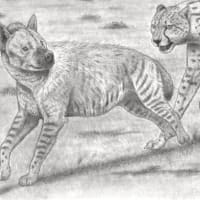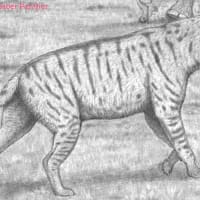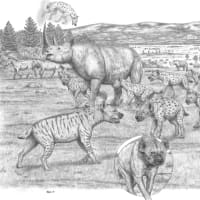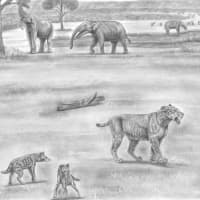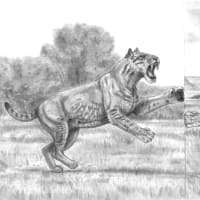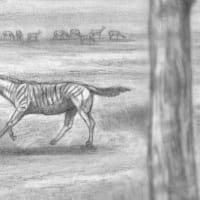Still intriguing Sabertooth Predation
by the Saber Panther
Here's an interesting new research that focuses on analysing difference in skull thickness and strength(it's not about the bite force) between dirk toothed Smilodon fatalis and scimitar toothed Homotherium serum and highlighting distinctive killing bites, predatory strategies and ecological adaptations of these two machairodontine cats.
www.cell.com/current-biology/f…
According to the research, S. fatalis had a considerably thicker cranial, especially in the rostrum area that was better equipped to withstand localised loads induced when stabbing prey with its hypertrophied canines but it was less optimised for resisting sustained, multidirectional loads in comparison with the skull of H. serum. The upper canines of H. serum were also more resistant to bending and presumably fracture under mediolaterally directed loads than were those of S. fatalis.
These diffrences in their cranial structures most likely reflect different ecological adaptations and predatory behaviors between the two machairodontines.
The forelimbs of H. serum exhibit greater adaptations for speed, whereas those of S. fatalis emphasize adaptations for strength. While S. fatalis probably used its powerfully built forelimbs with hypertrophied dew claws to bring down and immobilize prey and then applied one or two quick, strong killing bites to the throat, postcranial characteristics of H. serum imply less reliance on forelimbs for immobilization of prey than in S. fatalis, as well as a consequent need for craniodental morphologies better equipped to support lateral shaking.
The authors argue that, like S. fatalis, debilitating slashing bites to the throat of large prey was the likely predatory behavior of H. serum but it could also deploy a predatory behavior that was in between the canine-shear bite of S. fatalis and the clamp-and-hold technique of modern big cats.(though this 'intermediate predatory behavior' itself sounds to me kind of difficult how to interpret)
However, we know that there was considerable variation in postcranial morpho-types within so called 'scimitar toothed cats', from Amphimachairodus to Lokotunjailurus to Xenosmilus and so interpreting the relationship between typical killing techniques and the combination of craniodental and postcranial morphologies among fossil cats may not be so simple as it seems.
For instance, Xenosmilus hodsonae, in spite of its almost identical craniodental morphologis to those of Homotherium, had even more heavily built limbs than in Smilodon. Species of the tribe metailurini were also intriguing in that they possessed the combination of scimitar type fungs and pantherine like skeleton. On the other hand, across all cat like forms, even including barbourofelids and nimravids, 'dirk toothed cats' were universally characterised by more ambush-oriented, robust physique.
Secondary adaptations may be one of key factors to understand the situation of Xenosmilus, I think. Xenosmilus was one of the youngest known genus of the tribe homotherini which most likely branched off from some North American lineage of Homotherium and distributed over south eastern regions of North America and perhaps also part of Central America. These particular scimitar toothed predators most likely inhabited more densely vegetated, closed environments. They became considerably more robust and shorter limbed than their ancestors through adaptation, while the craniodental morphologies remained essentially the same because the scimitar tooth biting strategy, sometimes called as 'the cookie cutter bite' might prove to be highly effective for ambush predation as well.
In relation to that, I think that the authors' argument for 'subsequent need' for scimitar tooth craniodental morphologies in Homotherium might be somewhat erroneous, since these already appeared much earlier in Machairodus aphanistus and Nimravides catacopis, some oldest known homotherines who were in fact, similarly built to some dirk toothed cats(this uniformity in intratribal craniodental morphologies is one of distinctive features of homotherines).
The similar case of a secondary postcranial adaptation can be seen in the jaguar whose limbs became shorter and stockier compared to its Pleistocene ancestors with longer limbs. While the jaguar became somewhat smaller over time through adaptation, the continental tiger has retained both very large body frame and ambush oriented characteristics(long canines etc.) perhaps partly because of its habitats being more mosaicly vegetated(a combination of closed, hilly, open biomes). Some large metailurine cats, especially Dinofelisis cristata whose physique and the shape/length of canines are usually perceived as the most pantherine-like of all machairodonts, perhaps adapted to the life style and the habitat similar to those of the tiger(but I'm not sure).
At any rate, Xenosmilus still should be viewed as an oddball because through the evolutionary history, species of the tribe homotherini(scimitar toothed cats), from Nimravides to Amphimachairodus to Homotherium, did experience gradual, continual morphological shift toward longer limbed, cursorial adaptations, perhaps in response to continual global expansions of more open, relatively arid biomes. Smilodontines on the other hand, even though they were contemporaneous with homotherines in most of the time, experienced somewhat different adaptive evolution.
Below I select some representative large(over 135 kg(300 lbs) in body mass) saber toothed 'cats' from machairodontinae, barbourofelidae and nimravidae plus the tiger(as representative of pantherinae) and categorize them based on the body size(medium, large, very large), fung type(conical toothed, semi-conical toothed, scimitar toothed, dirk toothed), body build(gracile, moderately robust, robust, extremely robust), presumably dominant hunting orientation(ambush, cursorial, versatile) and presumably dominant biting method(clamp & hold bite, slashing bite, combination bite).
Amphimachairodus horribilis (machairodontinae) =very large, scimitar toothed, moderately robust, versatile, combination bite
Barbourofelis morrisi (barbourofelidae) =large, dirk toothed, extremely robust, ambush, slashing bite
Dinofelis pivetaui (machairodontinae) =medium, semi-conical toothed, moderately robust, versatile, combination bite
Homotherium serum (machairodontinae) =large, scimitar toothed, gracile, cursorial, combination bite
Hoplophoneus occidentalis (nimravidae) =medium, dirk toothed, extremely robust, ambush, slashing bite
Lokotunjailurus emageritus (machairodontinae) =large, scimitar toothed, gracile, cursorial, combination bite
Megantereon cultridens (machairodontinae) =medium, dirk toothed, robust, ambush, slashing bite
Panthera tigris tigris (pantherinae) =very large, conical toothed, moderately robust, versatile, clamp & hold bite
Quercylurus major (nimravidae) =very large, scimitar toothed, extremely robust, ambush, combination bite
Smilodon fatalis (machairodontinae) =very large, dirk toothed, robust, ambush, slashing bite
Xenosmilus hodsonae (machairodontinae) =very large, scimitar toothed, extremely robust, ambush, combination bite
Yes these are just overly simplified categorizations, nonetheless indicating how intriguing it still is to interpret predatory behaviors of saber toothed cats based on craniodental and postcranial characters. What do you think?










